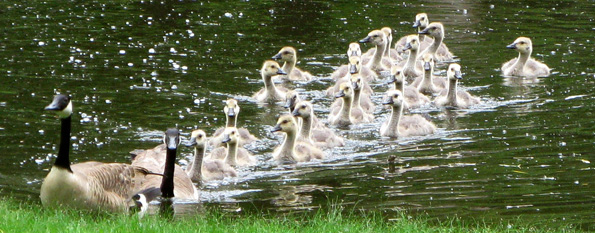
Bird Mating
The principle drive for birds forming a pair bond is to produce offspring. For all birds, the odds of producing surviving offspring are increased with a strong, healthy mate, which is why birds have different courtship rituals to find the most suitable partner. Once they have found that partner, mating may or may not lead to a longer attachment between two birds, and in fact many bird species will mate with several partners during the same nesting season in an effort to spread their genes to as many resulting eggs as possible.

Length of Mating Bonds
Different bird species remain in bonded pairs for different lengths of time. Some pair bonds, such as those for ruby-throated hummingbirds, last only as long as necessary for copulation, after which the male bird leaves and has no further role in building a nest, incubating the eggs or raising the hatchlings. Other birds, however, remain together throughout the nesting season with both partners working together to raise the brood, either by sharing duties or by one partner supporting the other by bringing extra food to the nest and deterring possible predators.
If a bird species can raise more than one brood in a nesting season, the same pair of partners may or may not work together on multiple broods. Some birds will stay monogamous only until the first eggs hatch, while others will remain together for the entire season but will go their separate ways after nesting season ends.
Birds that do form long term pair bonds may remain together for several breeding seasons without elaborate courtship renewals, though there may be some minor displays and other refreshing of their bond. Depending on the species, these birds may remain together until one partner dies, after which the other bird will seek another mate. Another common occurrence is that the birds stay together for several seasons, but they may find new, stronger partners at any time and could switch loyalties if they perceive that it would increase the chances of producing surviving offspring.
Birds that do stay together for several successive nesting seasons are often said to mate for life, even though those long term pair bonds may not, in fact, last the length of the birds’ lives.
Benefits of Long Term Mating
There are several benefits to long term pair bonds. While these benefits are not the same for every species, those that do appear to mate for life can take advantage of:
• Larger Territories: Birds that mate for several seasons tend to require larger territories. If they must make annual efforts to attract new mates, they would be unable to defend the amount of space they need for feeding. This is particularly true for birds of prey.
• Longer Youth Care: Larger birds require longer incubation periods for the young to fully form within the eggs, and after hatching the young birds require more extensive care or teaching from their parents. With long term bonds, the parent birds can mate earlier in the season and give their offspring the necessary time to develop fully before migration or harsh weather sets in. This is true for many large birds, including cranes, raptors and geese.
• Multiple Broods: While many birds that only mate for a single season also produce multiple broods, birds with long term bonds can often restart a brood if predators clean out a nest or if other circumstances destroy the eggs. This is another tactic birds can use to increase the odds of having viable offspring even in uncertain seasons. Birds of prey and many waterfowl have different nest threats that make long term bonds and multiple broods a necessity if their species are to survive.
Bird Species That Mate for Life
There are a number of bird species known to form long term, strong pair bonds that could be defined as mating for life. While any of these birds may seek a new mate if the pair cannot produce eggs or if one partner is injured or dies, bird species that are considered life mates include:
- Bald Eagles
- Mute Swans
- Canada Geese
- Common Ravens
- Barn Owls
- Red-Tailed Hawks
While roughly 90 percent of bird species are monogamous, that doesn’t mean they mate for life. Relatively few bird species form long term pair bonds that will last through multiple nesting seasons, but those that do use it as a tactic to increase their odds of producing surviving offspring that will be healthier and more adaptable to keep their species strong.